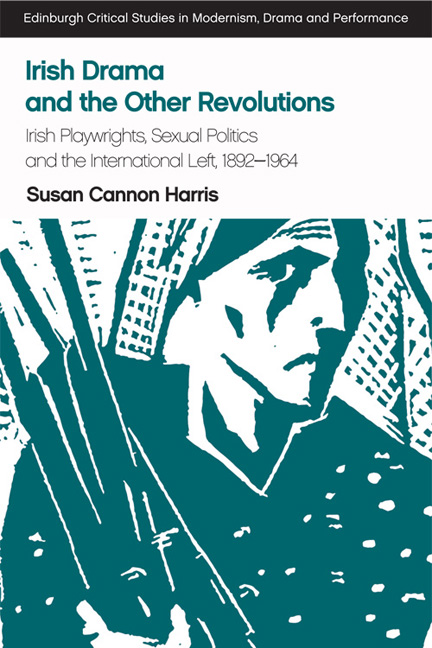 Irish Drama and the Other Revolutions
Irish Drama and the Other Revolutions Published online by Cambridge University Press: 06 January 2018
INTRODUCTION
The emergence of a Communist state had a transformative effect on left politics and left culture around the world. Within the Soviet Union, the radical break with the past catalysed an explosion of experimental art and literature, including a vibrant avant-garde theatre movement whose influence was felt throughout Europe and in the United States (Carter, The New Theatre, v). Outside the Soviet Union, the real-world existence of an ‘other place’ where capitalism's writ did not run changed both the content and the formal expression of utopian desire. The Soviet Union became a real destination towards which that desire could yearn; it promised, much more persuasively than experiments like the Garden City could, that socialism was a functional alternative to a capitalism whose days appeared to be numbered. It promised that the hoped-for utopian future was no longer queer; that it could be, and had been, realised in straight time.
Straight time has its privileges; and it has its price. With the establishment of the Communist International in 1919 (also known as the Third International or Comintern), the Soviet Union began its bid for ideological and tactical control of an international workers’ movement of which the Communist Party had until then been only one iteration. Though it was a long, chaotic and incomplete process, the establishment of the Comintern was the beginning of the end for syndicalism. Between a wave of repressive measures taken against them by capitalist governments and the Comintern's efforts to co-opt, infiltrate, merge with, or eradicate them, most national syndicalist organisations had withered away to irrelevance by the end of the 1920s (Darlington, Syndicalism, 3). The one exception to this trend was Spain, where the anarchosyndicalist Confederacion General del Trabajo (National Confederation of Labor, or CNT), remained a thorn in the side of their Marxist and Communist competitors and a major obstacle to Soviet hegemony – from the establishment of Spain's republican government in 1931, to the very bitter end of the Spanish Civil War in 1939.
The survival of anarcho-syndicalism and other non-Communist and anti- Communist left organisations in Spain helped make it one of the most dramatic, compelling and tragic subjects for left writers during the 1930s.
To save this book to your Kindle, first ensure [email protected] is added to your Approved Personal Document E-mail List under your Personal Document Settings on the Manage Your Content and Devices page of your Amazon account. Then enter the ‘name’ part of your Kindle email address below. Find out more about saving to your Kindle.
Note you can select to save to either the @free.kindle.com or @kindle.com variations. ‘@free.kindle.com’ emails are free but can only be saved to your device when it is connected to wi-fi. ‘@kindle.com’ emails can be delivered even when you are not connected to wi-fi, but note that service fees apply.
Find out more about the Kindle Personal Document Service.
To save content items to your account, please confirm that you agree to abide by our usage policies. If this is the first time you use this feature, you will be asked to authorise Cambridge Core to connect with your account. Find out more about saving content to Dropbox.
To save content items to your account, please confirm that you agree to abide by our usage policies. If this is the first time you use this feature, you will be asked to authorise Cambridge Core to connect with your account. Find out more about saving content to Google Drive.